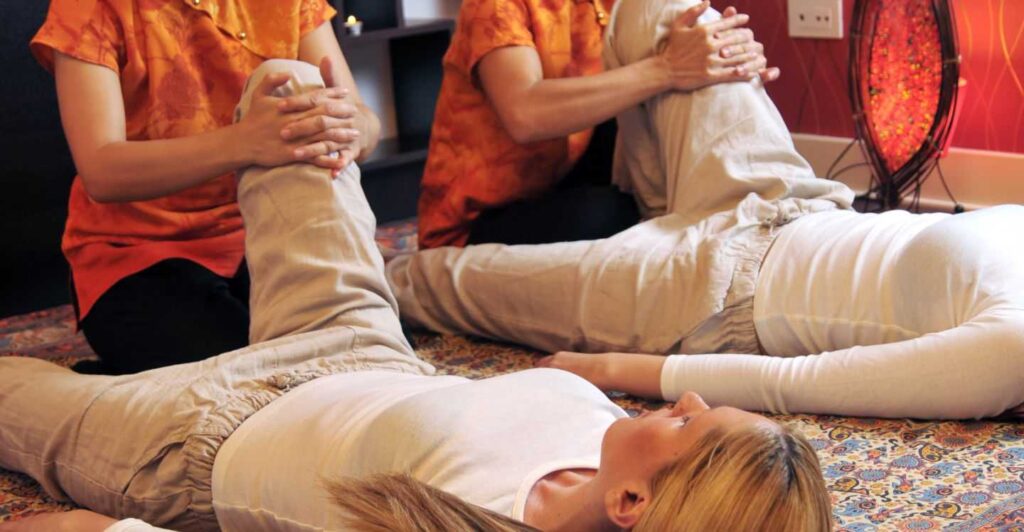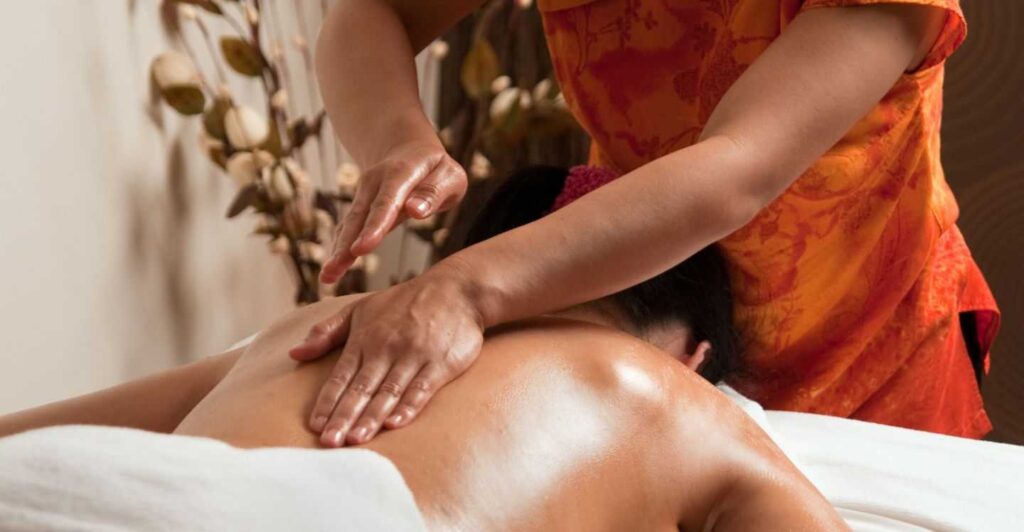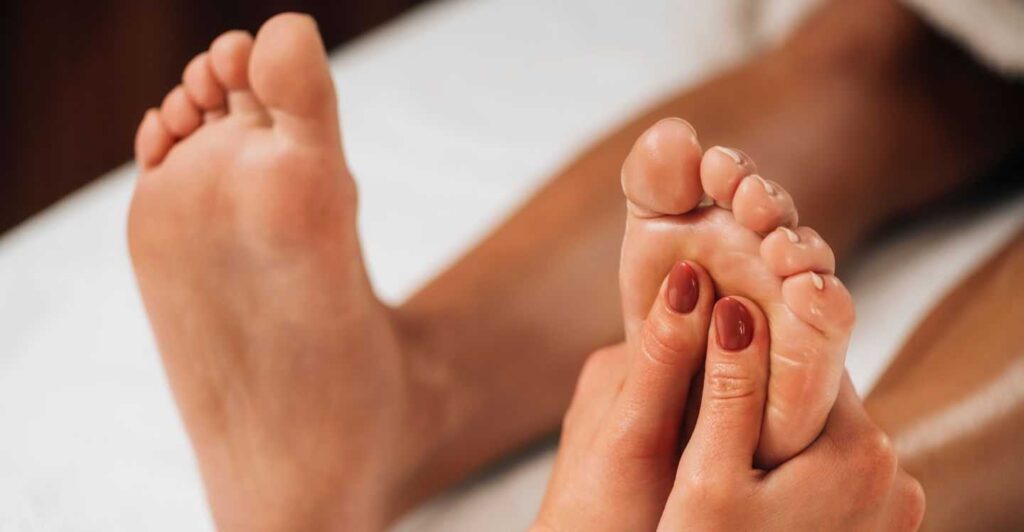What is Thai massage?
Thai massage is a traditional healing art that has been practiced for thousands of years in Thailand. It is a form of bodywork that combines passive stretching, compression, and acupressure to release tension and improve energy flow in the body. Unlike other forms of massage, traditional Thai massage is performed on a mat on the floor, with the recipient fully clothed in loose, comfortable clothing. The therapist uses their hands, feet, elbows, and knees to apply pressure and manipulate the body into various positions and stretches. The goal of Thai massage is to promote overall health and well-being by restoring balance and harmony to the body and mind.
Introduction of traditional Thai massage
Traditional Thai massage, also known as Nuad Thai, is an ancient healing art that originated in Thailand over 2,500 years ago. It is believed to have been developed by a physician named Jivaka Kumar Bhaccha, who was a contemporary of the Buddha. Traditional Thai massage incorporates elements of yoga, Ayurveda, and Chinese medicine, and is based on the concept of energy lines, or Sen lines, which run throughout the body.
According to Thai tradition, energy blockages in the body can lead to pain, illness, and emotional imbalance. By applying pressure and manipulating the body in specific ways, Thai massage can help to release these blockages and restore balance and harmony to the body and mind. Traditional Thai massage is deeply rooted in Thai culture and is still widely practiced throughout Thailand today.

How is Thai massage different from other types of massage?
Thai massage is different from other forms of traditional massage (like Swedish massage) in several ways. First, it is performed on a mat on the floor rather than on a massage table. This allows for a greater range of movement and flexibility in both the recipient and the therapist.
Second, it is performed with the recipient fully clothed in loose, comfortable clothing, which allows for ease of movement and flexibility.
Third, it involves more stretching and joint manipulation than other forms of massage, which helps to increase mobility and flexibility in the body.
Finally, Thai massage incorporates acupressure and energy work, which can help to balance the body’s energy and promote overall health and well-being.
What does a Thai massage include?
A typical Thai massage session usually lasts between 60 and 90 minutes, but in Chada Thai massage salons 120 minute long massages are also available. The massage therapy is performed on a mat on the floor, with the recipient wearing comfortable clothing. The practitioner begins by warming up the body with gentle compressions and stretches, and then progresses to deeper stretches and joint manipulations. Throughout the massage, the therapist may use their hands, feet, elbows, and knees to apply pressure and manipulate the body into various positions and stretches. The massage also includes acupressure and energy work, which helps to balance the body’s energy and promote overall health and well-being. Herbal compresses or aromatherapy can also be used to enhance the therapeutic benefits of the massage.
The benefits of Thai massage
Thai massage offers a wide range of benefits for both the body and the mind. One of the primary benefits of Thai massage is that it can help to release tension and stiffness in the muscles, joints and connective tissues which can help to improve mobility and flexibility. The stretching and joint manipulation techniques used in Thai massage can also help to increase range of motion and reduce the risk of injury.
Thai massage can also help to promote relaxation and reduce stress and anxiety. The acupressure and energy work used in Thai massage can help to balance the body’s energy and promote a sense of calm and well-being. In addition, the deep pressure and rhythmic movements used in Thai massage can help to stimulate the release of endorphins, which are natural painkillers and mood enhancers.
Other benefits of Thai massage include improved circulation, increased energy levels, and enhanced immune function. Thai massage can also help to reduce headaches, alleviate back pain, and improve digestion. Overall, Thai massage is a holistic therapy that can help to promote overall health and wellbeing in both the body and the mind.
What to expect from Thai massage?
If you have never experienced Thai massage before, it is important to know what to expect. When you arrive for your session, your therapist will typically ask you some questions about your health and any areas of concern you may have.
During the massage, you will wear loose, comfortable clothing. We provide comfortable clothing for the massage, so you don’t need to bring your own. The massage is performed on a mat on the floor. Your therapist will use a variety of techniques to manipulate your body into different positions and stretches, using their hands, feet, elbows, and knees to apply pressure and release tension.
Throughout the treatment, the practitioner may use acupressure and energy work to balance the body’s energy and promote relaxation and well-being. You can also choose Thai massage with herbal compresses or aromatherapy to enhance the therapeutic benefits of the massage. Please keep in mind that during a massage with aromatic oil, the guest does not wear clothes.

It is important to communicate with your therapist throughout the session to ensure that the pressure and techniques used are comfortable and appropriate for you. If at any point you feel uncomfortable or in pain, you should speak up and let your therapist know.
After the treatment, you may feel relaxed and energized. It is important to drink plenty of water and rest for a while to allow your body to fully integrate the therapeutic benefits of the massage.
Why is Thai massage so popular?
Thai massage has become increasingly popular in recent years, both in its country of origin, Thailand, and around the world. There are several reasons why Thai massage is so popular:
- Holistic approach: Thai massage is a holistic therapy that addresses the body, mind, and spirit as a whole, rather than focusing on individual symptoms or conditions.
- Unique techniques: It uses unique techniques, including stretching, joint manipulation, and acupressure, that are not commonly used in other forms of massage.
- Health benefits: It offers a wide range of health benefits, including improved mobility and flexibility, reduced stress and anxiety, improved circulation, reduced muscle and joint pain, and enhanced immune function.
- Cultural significance: It is deeply rooted in Thai culture and has been practiced for thousands of years. Many people are drawn to the cultural significance and history of this ancient healing art.
- Customizable: It can be customized to suit the individual needs and preferences of the client, making it a versatile and adaptable therapy.
- Accessible: It can be performed on a mat on the floor, which makes it accessible to people who may have difficulty getting on and off a massage table.
Overall, Thai massage offers a unique and effective approach to healing and wellness that has resonated with people around the world.
When Thai massage is recomended?
Thai massage can be recommended for a variety of reasons, including:
- Reducing stress and anxiety: It is known for its relaxing and calming effects, making it an ideal therapy for reducing stress and anxiety.
- Relieving muscle tension and pain: It uses a combination of stretching, acupressure, and deep tissue techniques to release muscle tension and alleviate pain.
- Improving flexibility and mobility: The stretching and joint mobilization techniques used in Thai massage can help improve flexibility and mobility, making it a great therapy for athletes and people with mobility issues.
- Boosting immune function: It has been shown to stimulate the immune system, which can help improve overall health and reduce the risk of illness.
- Improving circulation: The acupressure and massage techniques used in Thai massage can help improve blood and lymphatic circulation, which can improve overall health and well-being.
- Promoting relaxation and well-being: It is known for its ability to promote relaxation and a sense of well-being, making it an ideal therapy for people looking to reduce stress and improve their overall quality of life.
Overall, Thai massage can be recommended for a variety of reasons, and is often used as a complementary therapy alongside other forms of healthcare. However, it is important to consult with a healthcare provider before beginning any new form of therapy, including Thai massage.
When Thai massage is not recomended?
While Thai massage is generally safe and beneficial for most people, there are some situations where it may not be recommended. These include:
- Inflammatory conditions: If you have an inflammatory condition, such as arthritis or tendinitis, Thai massage may exacerbate your symptoms and should be avoided.
- Recent injuries: If you have recently suffered an injury, such as a muscle strain or sprain, Thai massage may not be appropriate until the injury has healed.
- Open wounds or skin conditions: If you have open wounds, cuts, or skin conditions such as eczema or psoriasis, Thai massage may irritate or exacerbate these conditions.
- Pregnancy: While Thai massage can be adapted for pregnant women, it is important to consult with your doctor before beginning any new form of therapy during pregnancy.
- Blood disorders: If you have a blood disorder, such as hemophilia or deep vein thrombosis, Thai massage may not be appropriate due to the risk of bleeding or blood clots.
- Recent surgery: If you have recently undergone surgery, Thai massage may not be recommended until you have fully healed and received clearance from your doctor.
It is important to always consult with your doctor or a healthcare provider before beginning any new form of therapy, including Thai massage, especially if you have any underlying health conditions or concerns.

Risks and side effects of Thai massage
Like any form of therapy, there are potential side effects and risks associated with Thai massage. These include:
- Soreness or discomfort: Due to the deep tissue and stretching techniques used in Thai massage, some people may experience soreness or discomfort following a session.
- Bruising: As with any form of massage, bruising may occur in some cases, particularly if you have sensitive skin or if your massage therapist uses deep pressure.
- Headaches: Some people may experience headaches following a massage session, particularly if they are dehydrated or have tension in their neck and shoulders.
- Injuries: In rare cases, injuries such as muscle strains or sprains may occur during a Thai massage session.
- Allergic reactions: If you have allergies to any of the oils, lotions, or other products used during a Thai massage, you may experience an allergic reaction. Please inform your massage therapist if you are aware of any type of allergy.
It is important to communicate openly with your massage therapist and let them know if you experience any discomfort or pain during the session. Additionally, it is important to ensure that you receive Thai massage from a licensed and experienced massage therapist to minimize the risk of injury or adverse effects.
If you have any underlying health conditions or concerns, it is important to consult with your doctor before beginning any new form of therapy, including Thai massage, to ensure that it is safe for you.
How often to get Thai massages
How often you should get a Thai massage depends on your individual needs and preferences. Some people may benefit from weekly or bi-weekly Thai massage sessions, while others may find that monthly or occasional sessions are sufficient to achieve their desired results.
If you are experiencing chronic pain or tension, or if you have a specific injury or condition that you are seeking to address with Thai massage, you may benefit from more frequent sessions. On the other hand, if you are using Thai massage as a form of relaxation or stress relief, you may find that less frequent sessions are still effective.
It is important to listen to your body and work with your massage therapist to determine a schedule that works best for you. Your massage therapist may also be able to provide guidance on how often you should receive Thai massage based on your individual needs and goals.
Ultimately, the frequency of your Thai massage sessions will depend on a variety of factors, including your overall health and wellness goals, your level of physical activity, and your individual response to the massage. By working closely with your massage therapist and paying attention to your body’s needs, you can determine a schedule that helps you achieve the best possible results from your Thai massage sessions.
Summary
In summary, Thai massage is an ancient healing art that offers numerous health benefits and a unique therapeutic experience. It involves passive stretching, compression, and acupressure to release tension and improve energy flow in the body. While it is generally considered safe, it is important to be aware of potential risks and to communicate any concerns with your therapist. With regular treatments, Thai massage can help to promote overall well-being and a sense of relaxation and balance in the body and mind.





